一、概念
之前在队列的时候讲过,队列是先进先出的,是根据你的插入顺序来确定优先级的。
而有时候我们希望可以通过元素内容来确定优先级。
比如:在手机上玩游戏的时候,如果有来电,那么系统应该优先处理打进来的电话;初中那会班主任排座位时可能会让成绩好的同学先挑座位。
在这种情况下, 数据结构应该提供两个最基本的操作,一个是返回最高优先级对象,一个是添加新的对象 。这种数据结构就是优先级队列 (Priority Queue) 。
堆的性质:
- 堆总是一棵完全二叉树。
- 堆中某个节点的值总是不大于或不小于其父节点的值。如果是某个节点值大于左右结点就是大根堆 。如果是某个节点值小于左右结点,就是小根堆。
二、堆的底层结构
堆实际上是二叉树的顺序存储,就是用数组的方式,来表示二叉树。
小根堆:
而且我们可以发现,数组中的存储顺序是层序遍历的结果
大根堆:
从堆的概念可知,堆是一棵完全二叉树,因此可以层序的规则采用顺序的方式来高效存储
如果不是完全二叉树:
中间就会浪费许多空间,所以并不是一个好的选择
如果是一个完全二叉树:
不仅不会浪费空间,我们还可以利用完全二叉树的一些公式:
- 如果i为0,则i表示的节点为根节点,否则****i节点的父亲节点为 (i - 1)/2
- 如果2 * i + 1 小于节点个数,则节点i的左孩子下标为2 * i + 1,否则没有左孩子
- 如果2 * i + 2 小于节点个数,则节点i的右孩子下标为2 * i + 2,否则没有右孩子
三、堆的实现和创建
我们一边写代码一边进行画图介绍
首先创建一个堆类,指定堆初始大小为10,可以传入数组:
java
public class MyHeap {
//存放数组元素
private int[] elem;
//记录有效数据个数
private int usedSize;
//初始化为10
public MyHeap() {
elem = new int[10];
}
//初始化
public void init(int[] array) {
for (int i = 0; i < elem.length && i < array.length; i++) {
elem[i] = array[i];
usedSize++;
}
}
}1.将数据转化为堆的存储
那么我们如何把数组转化为,表示堆的逻辑呢?
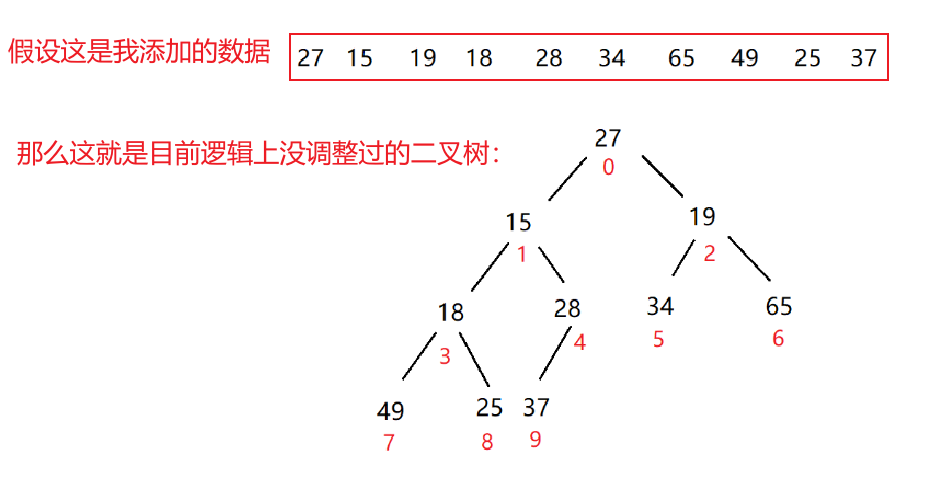
我们要将现在的这串数据转化为堆,相信大家想到的是通过逆序排序就直接Ok了。
那我问你
所以单纯的逆序排序是不太ok的
正确的排序方式:
我们现在就可以写一部分代码了:
javapublic void createHeap() { for (int parent = (usedSize-1-1) / 2; parent >= 0; parent--) { //用来调整 siftDown(); } } private void siftDown() { }
继续之前的操作:最终代码实现:
javapublic void createHeap() { for (int parent = (usedSize-1-1) / 2; parent >= 0; parent--) { //用来调整 siftDown(parent,usedSize); } } private void siftDown(int parent, int end) { //假设左孩子是最大值 //通过 i * 2 + 1 = 左子树 int child = (parent * 2) + 1; //孩子节点越界就说明结束了 while (child < end) { //右孩子没有越界的情况 左孩子 < 右孩子 吗? if (child + 1 < end && elem[child] < elem[child+1]) { //右孩子比左孩子大 child++; } //孩子节点大于父亲节点 if (elem[child] > elem[parent]) { swap(parent,child); parent = child; child = (child * 2) + 1; }else { //说明不需要调整了 break; } } } private void swap(int i, int j) { int tmp = elem[i]; elem[i] = elem[j]; elem[j] = tmp; }那么来测试一下:
javapublic static void main(String[] args) { int [] array = {27,15,19,18,28,34,65,49,25,37}; MyHeap myHeap = new MyHeap(); myHeap.init(array); myHeap.createHeap(); }结果:
2.在堆中添加数据
由于我们本质是通过数组存储的,所以还是会存在数组满的情况,那就需要判断一下是不是满了,满了就扩容。
那我们就当是已经解决了长度不够的问题:
代码:
javapublic void offer(int val) { if (isFull()) { elem = Arrays.copyOf(elem,elem.length * 2); } elem[usedSize] = val; usedSize++; siftUp(usedSize-1); } private void siftUp(int child) { //计算父亲节点位置 int parent = (child - 1) / 2; while (parent >= 0) { if (elem[parent] < elem[child]) { swap(parent,child); child = parent; parent = (child - 1) / 2; }else { break; } } }测试:
javapublic static void main(String[] args) { int [] array = {27,15,19,18,28,34,65,49,25,37}; MyHeap myHeap = new MyHeap(); myHeap.init(array); myHeap.createHeap(); myHeap.offer(70); }结果:
如果我们直接通过offer方法来创建堆呢?是不是每一次都是堆,测试一下:
javapublic static void main(String[] args) { MyHeap myHeap = new MyHeap(); myHeap.offer(27); myHeap.offer(15); myHeap.offer(19); myHeap.offer(18); myHeap.offer(28); myHeap.offer(34); myHeap.offer(65); myHeap.offer(49); myHeap.offer(25); myHeap.offer(37); }根据结果看虽然顺序会有不同,但是仍然是满足大根堆条件的。
3.堆中删除数据
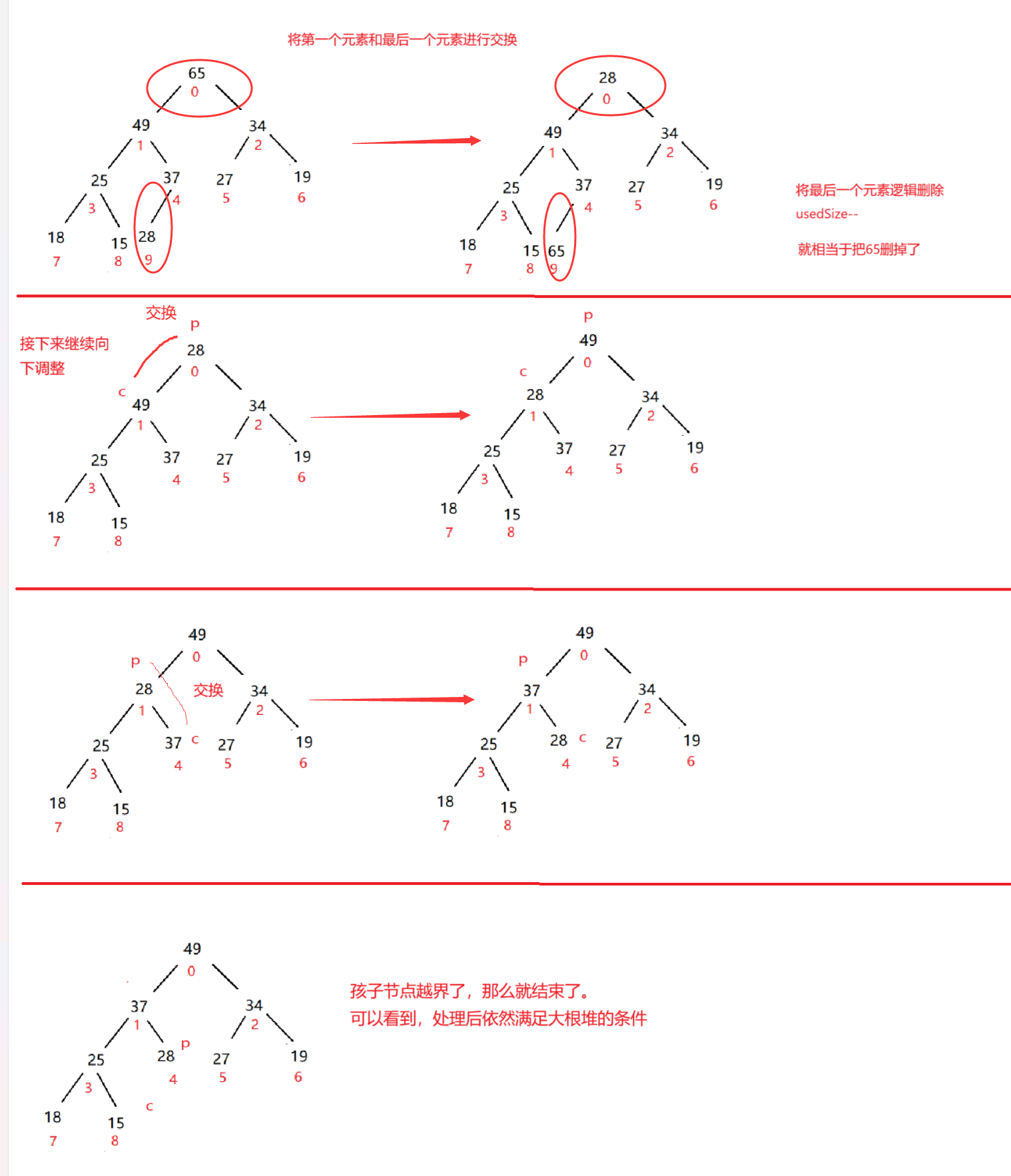
代码实现:
java
public int poll() {
//判断是否为null
if (isEmpty()) {
return -1;
}
int old = elem[0];
//交换后逻辑删除
swap(0,usedSize-1);
usedSize--;
//向下调整
siftDown(0,usedSize);
return old;
}
private boolean isEmpty() {
return usedSize == 0;
}
四、PriorityQueue
**1.**特性
Java 集合框架中提供了 PriorityQueue 和 PriorityBlockingQueue 两种类型的优先级队列, PriorityQueue 是线 程不安全的, PriorityBlockingQueue 是线程安全的 ,本文主要介绍 PriorityQueue 。
关于PriorityQueue的使用要注意:
- PriorityQueue中放置的元素必须要能够比较大小,不能插入无法比较大小的对象,否则会抛出ClassCastException异常
- 不能插入null对象,否则会抛出****NullPointerException
- 没有容量限制,可以插入任意多个元素,其内部可以自动扩容(理论上的,实际肯定是不可以无限插入的)
- 插入和删除元素的时间复杂度为O(log2N)
- PriorityQueue****底层使用了堆数据结构
- PriorityQueue****默认情况下是小堆---即每次获取到的元素都是最小的元素
- 使用时必须导入PriorityQueue所在的包,即:
javaimport java.util.PriorityQueue;
2.常用方法函数名
|--------------------|---------------------------------------------------------------------------------|
| 函数名 | 功能介绍 |
| boolean offer(E e) | 插入元素 e ,插入成功返回 true ,如果 e 对象为空,抛出 NullPointerException 异常,时 间复杂度,注意:空间不够时候会进行扩容 |
| E peek() | 获取优先级最高的元素,如果优先级队列为空,返回 null |
| E poll() | 移除优先级最高的元素并返回,如果优先级队列为空,返回 null |
| int size() | 获取有效元素的个数 |
| void clear() | 清空 |
| boolean isEmpty() | 检测优先级队列是否为空,空返回 true |
java
public static void main(String[] args) {
PriorityQueue<Integer> queue = new PriorityQueue<>();
//判断是否为null
System.out.println(queue.isEmpty());
//入堆
queue.offer(21);
queue.offer(56);
queue.offer(44);
queue.offer(23);
//看一下堆顶元素
System.out.println(queue.peek());
//返回堆顶元素并退出
System.out.println(queue.poll());
System.out.println(queue.poll());
//返回堆中元素个数
System.out.println(queue.size());
//清控堆中元素
queue.clear();
//再次判断是否为null
System.out.println(queue.isEmpty());
}结果:
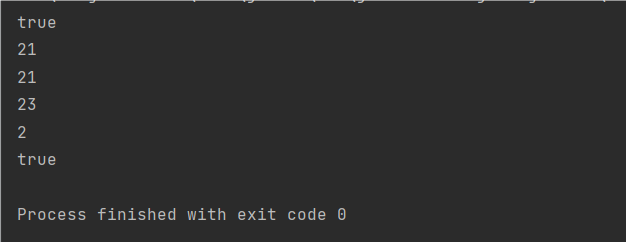
3.PriorityQueue的构造方法
|------------------------------------------------|----------------------------------------------------------------------------------------------|
| 构造函数 | 功能介绍 |
| PriortiyQueue() | 创建一个空的优先级队列,默认容量是11 |
| PriortiyQueue(int initialCapacity) | 创建一个初始容量为 initialCapacity 的优先级队列,注意:initialCapacity不能小于 1 ,否则会抛 IllegalArgumentException 异 常 |
| PriortiyQueue(Collection<? extends E> c) | 用一个集合来创建优先级队列 |
它们多数都调用了,有两个参数的构造方法。这两个参数的构造方法,给了一个比较器,你可以通过这个比较器来控制大根堆或小根堆。(两个参数的构造方法后面再做介绍他的作用)

3.1 参数为 Collection<? extends E> c 的构造方法
意思是只要实现了Collection的数据结构都可以转换为堆:
java
public static void main(String[] args) {
LinkedList<Integer> list = new LinkedList<>();
list.add(23);
list.add(34);
list.add(45);
list.add(56);
list.add(67);
list.add(78);
//将链表
PriorityQueue<Integer> queue = new PriorityQueue<>(list);
System.out.println(queue.toString());
}结构:

3.2 通过Comparator实现大根堆小根堆的控制
有这样一个构造方法,传入构造器就可以对控制元素的比较:

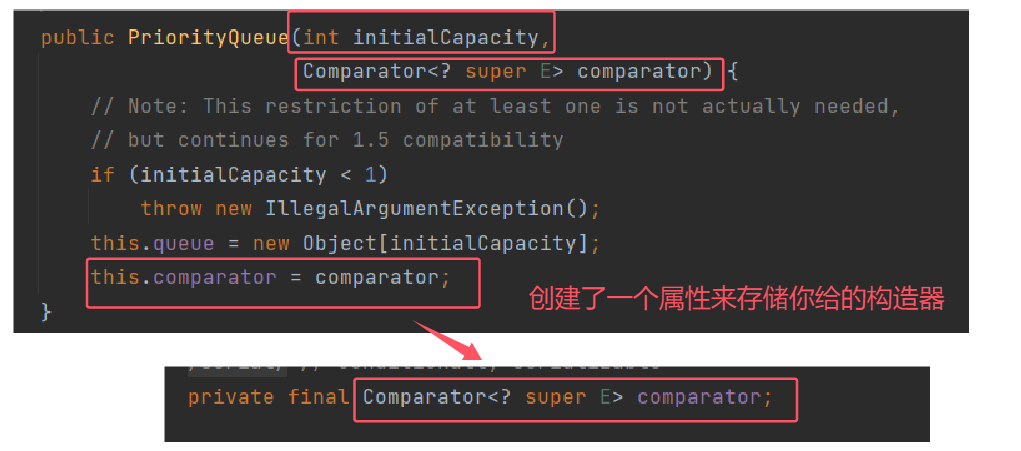
我们需要创建一个比较器:
java
class IntCmp implements Comparator<Integer> {
//大根堆写法
@Override
public int compare(Integer o1, Integer o2) {
return o2.compareTo(o1);
}
//小根堆写法
// @Override
// public int compare(Integer o1, Integer o2) {
// return o1.compareTo(o2);
// }
}测试一下:
java
public static void main(String[] args) {
PriorityQueue<Integer> queue = new PriorityQueue<>(new IntCmp());
queue.offer(23);
queue.offer(34);
queue.offer(45);
queue.offer(56);
queue.offer(67);
queue.offer(78);
System.out.println(queue.toString());
}
那代码是如何实现的呢?我们来看一下
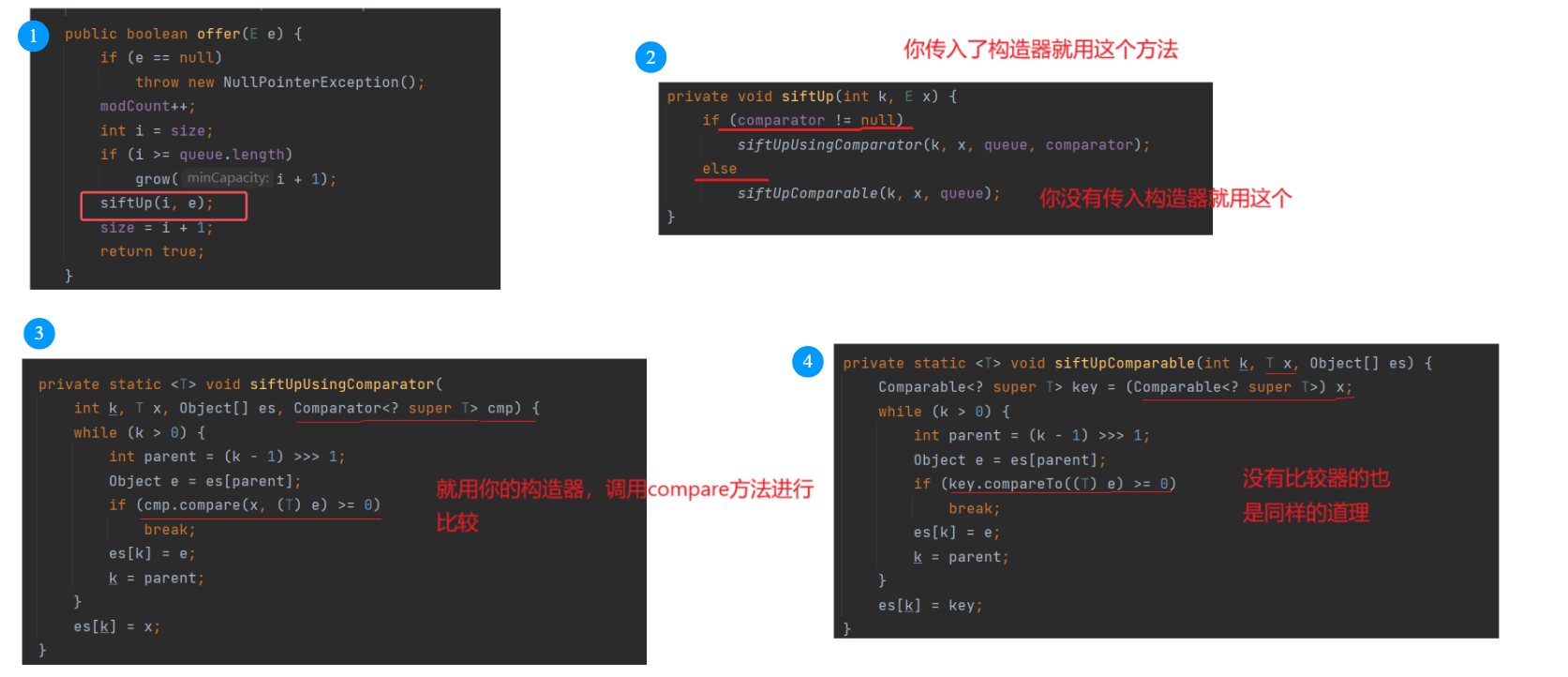
大家可能compare和compareTo看懵了,我们来查看一下Integer里面实现的:
如果是我们自己的类如何比较呢?
我们有这样一个学生类:
java
class Student {
public int age;
public Student(int val) {
age = val;
}
}
java
public static void main(String[] args) {
PriorityQueue<Student> queue = new PriorityQueue<>();
queue.offer(new Student(9));
queue.offer(new Student(12));
queue.offer(new Student(45));
queue.offer(new Student(43));
}我们并没有指定Student的比较方式,这是不被允许的

那我们就就处理一下:
java
class Student implements Comparable<Student>{
public int age;
public Student(int val) {
age = val;
}
@Override
public int compareTo(Student o) {
return this.age - o.age;
}
@Override
public String toString() {
return age + " ";
}
}
class IntCmp implements Comparator<Student> {
//大根堆写法
@Override
public int compare(Student o1, Student o2) {
//这里去调用Student的compareTo
return o2.compareTo(o1);
}
//小根堆写法
// @Override
// public int compare(Student o1, Student o2) {
// return o1.compareTo(o2);
// }
}测试:
java
public static void main(String[] args) {
PriorityQueue<Student> queue = new PriorityQueue<>(new IntCmp());
queue.offer(new Student(9));
queue.offer(new Student(12));
queue.offer(new Student(45));
queue.offer(new Student(43));
System.out.println(queue.toString());
}
五、堆排序
经过上面这么多图的讲解,我们现在就知道了,如果是大根堆,堆顶元素一定是最大值,反之就是最小值 。那我们就可以像删除元素那样,把最后第一个元素和最后一个元素交换 ,再进行操作保证仍然是堆,那么现在堆底元素就是最大值。下一次堆顶元素就是第二大的值了,以此类推。
图解:
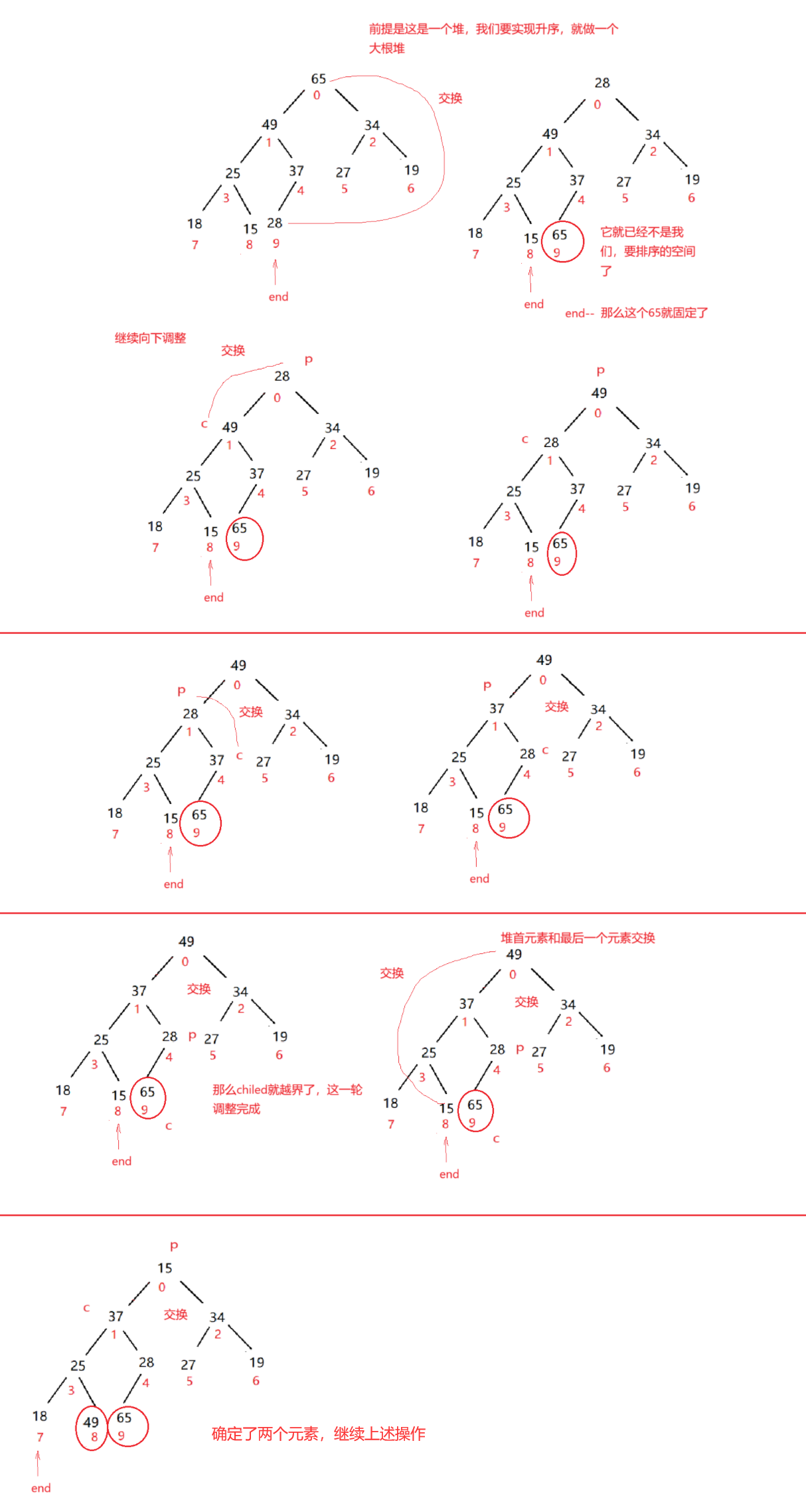
代码:
java
/**
* 堆排序
* 时间复杂度:O(log2n * n)
* 空间复杂度:O(N)
* 稳定性:不稳定
*/
public void heapSort(int[] array) {
//先调整为大根堆
createHeap(array);
//end控制未排序数据的末尾
int end = array.length - 1;
while (end >= 0) {
//交换堆首和堆尾元素
swap(array,0,end);
//向下调整
siftDown(array,0,end);
//有效数据已经放到末尾
end--;
}
}
private void createHeap(int[] array) {
for (int parent = (array.length-1-1) / 2; parent >= 0; parent--) {
//用来调整
siftDown(array,parent,array.length);
}
}
private void siftDown(int[] array, int parent, int end) {
//假设左孩子是最大值
//通过 i * 2 + 1 = 左子树
int child = (parent * 2) + 1;
//孩子节点越界就说明结束了
while (child < end) {
//右孩子没有越界的情况 左孩子 < 右孩子 吗?
if (child + 1 < end && array[child] < array[child+1]) {
//右孩子比左孩子大
child++;
}
//孩子节点大于父亲节点
if (array[child] > array[parent]) {
swap(array,parent,child);
parent = child;
child = (child * 2) + 1;
}else {
//说明不需要调整了
break;
}
}
}
private void swap(int[] array, int i, int j) {
int tmp = array[i];
array[i] = array[j];
array[j] = tmp;
}测试:
java
public static void main(String[] args) {
MyHeap heap = new MyHeap();
int[] array = {27,15,19,18,28,34,65,49,25,37};
heap.heapSort(array);
}














